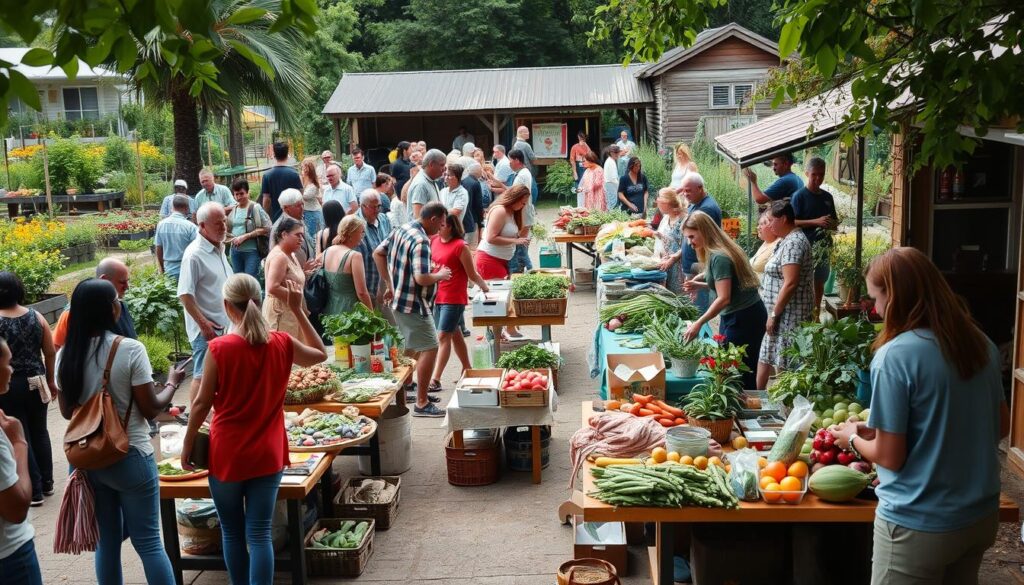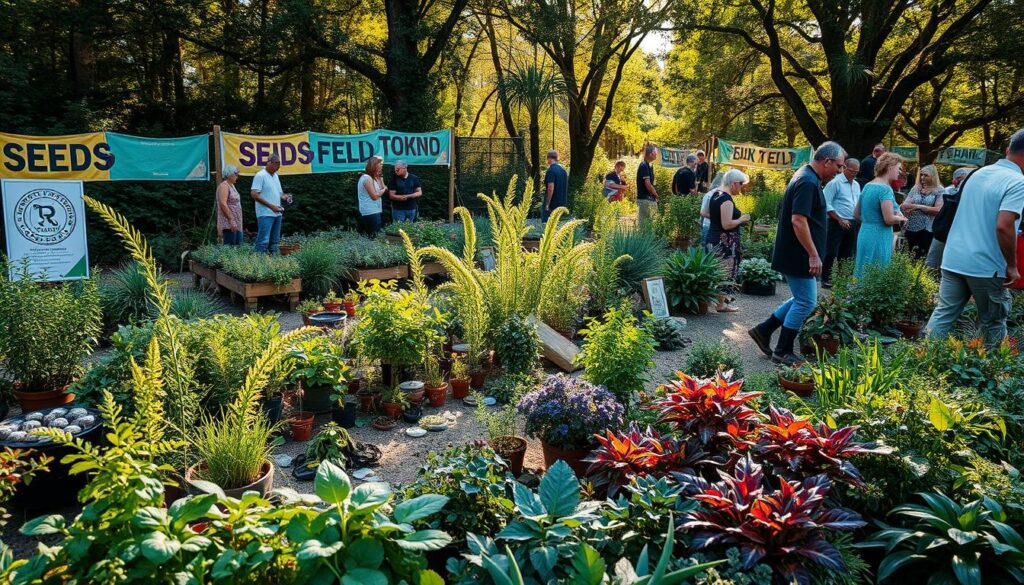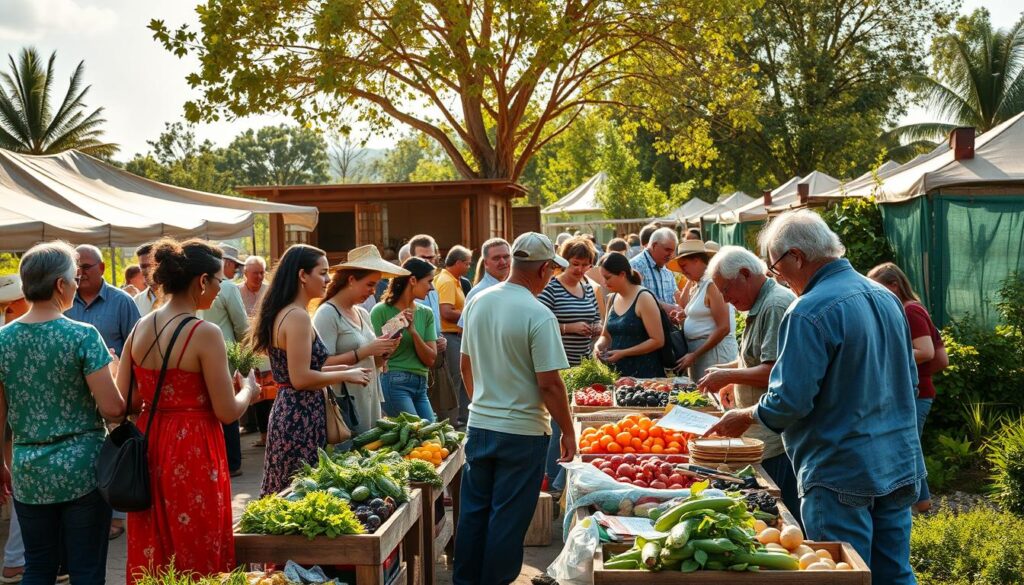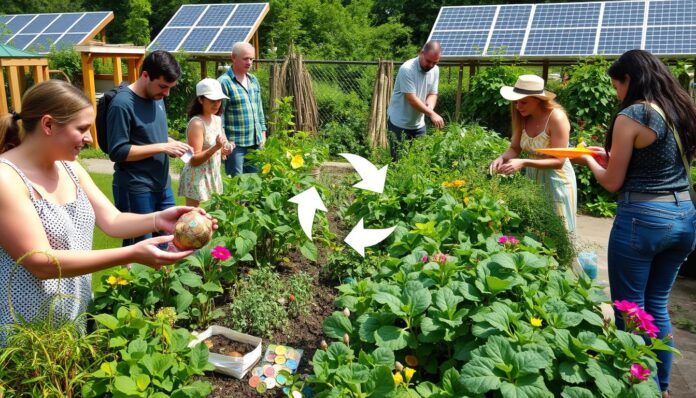A surprising fact is that alternative currencies can include foreign currencies, locally created currencies, and cryptocurrencies like Bitcoin. They offer a way to exchange value in permaculture, promoting sustainable finance. Using alternative currency in permaculture can help create a more community-based economy. This is key for sustainable practices.
In the United States, the idea of alternative currency in permaculture is becoming more popular. Many organizations and individuals are exploring its potential. They see it as a way to support sustainable finance and community development.
Using alternative currencies in permaculture can greatly benefit the environment and local communities. It helps reduce dependence on traditional financial systems. This promotes more sustainable and fair economic practices.
This guide will cover alternative currencies in permaculture in detail. We’ll look at their benefits, challenges, and how to implement them. Our focus will be on sustainable finance and community-based economics.
Key Takeaways
- Alternative currencies can promote sustainable finance and community-based economics in permaculture.
- The use of alternative currency permaculture can lead to a more equitable and environmentally friendly economic system.
- Implementing alternative currencies in permaculture requires a thorough understanding of the benefits and challenges involved.
- Alternative currency permaculture can be used to promote local economic development and community engagement.
- Sustainable finance and community-based economics are essential for the long-term success of permaculture projects.
- Alternative currencies can provide a means of exchange that is not reliant on traditional financial systems.
Understanding Alternative Currencies in Permaculture
Alternative currencies are key in permaculture. They support community-based economics and regenerative agriculture. These can be local currencies, time banks, or mutual credit systems. They help people and communities use money in more sustainable ways.
For example, Bay Bucks in Traverse City and Common Good are types of alternative currencies. They let people buy goods and services locally. This keeps money in the community and helps local farmers and food producers.
These currencies also tackle problems with traditional money like scarcity and inflation. They offer a stable way to exchange goods and services. As community-based economics grows, alternative currencies will become even more vital for a sustainable economy.
| Alternative Currency | Description |
|---|---|
| Bay Bucks | A local currency in Traverse City |
| Common Good | A regional currency with both digital and physical forms |
| Mutual Credit Clearing | A system for exchanging goods and services without using traditional currency |
Historical Context of Alternative Currencies
For centuries, people have used different ways to trade things. One of these is the local exchange trading system. It lets people swap goods and services without using money. This idea has been seen in many places, like Australia, where it was shaped by the permaculture movement.
In the late 1990s, a special local currency was introduced in the NSW Northern Rivers region. It was a big step for alternative currencies. The Blue Mountains LETS was the biggest LETS system in the world at that time. The growth of LETS in Australia was inspired by the permaculture movement of the 1980s.
A barter economy is another way to trade without money. It has been around for ages, even in ancient times. The push for alternative currencies like LETS and barter economies comes from wanting a fair and sustainable economy.

| Alternative Currency | Description |
|---|---|
| Local Exchange Trading System | A system that allows individuals to exchange goods and services without using traditional currency |
| Barter Economy | A system where individuals exchange goods and services directly without using money |
Types of Alternative Currencies Used in Permaculture
Permaculture has led to many alternative currencies. Each has its own special features and benefits. These currencies help with sustainable finance and community-based economics. They often include green investments and crypto permaculture.
Local Currencies
Local currencies work within a specific area. They help grow the local economy and bring people together. You can use them to buy things from local shops, helping the local economy grow.
Time Banks
Time banks use time as money. You earn time credits by helping others. Then, you can use those credits to get help when you need it. This way, everyone helps each other out.
Cryptocurrency and Blockchain
Cryptocurrency and blockchain are changing how we think about money in permaculture. They let people invest in green projects. Blockchain makes it easy to track and exchange these currencies safely and openly.
| Alternative Currency | Benefits |
|---|---|
| Local Currencies | Promotes local economic development, community engagement |
| Time Banks | Fosters community reciprocity, cooperation, mutual support |
| Cryptocurrency and Blockchain | Promotes green investments, sustainable projects, transparent and secure systems |
Benefits of Using Alternative Currencies in Permaculture
Alternative currencies in permaculture bring many benefits. They help the economy, protect the environment, and build community. Using local currencies keeps money in the area, helping small businesses grow. This supports ethical finance and helps these businesses stay afloat.
Local currencies also cut down on carbon emissions. For example, the Bristol Pound helps keep money in Bristol. Time banks, like the Onion River Exchange, let people trade services without money. This boosts community strength and supports alternative currency permaculture.

- Increased support for small businesses
- Reduced carbon emissions
- Promoting local job retention
- Combating social isolation by fostering personal connections among community members
By using alternative currencies, communities can share wealth more fairly. Successful examples, like BerkShares in Massachusetts, show how it works. Alternative currencies help build stronger, more united communities.
Implementing Alternative Currencies in Permaculture Projects
Using alternative currencies in permaculture projects means understanding sustainable finance and community-based economics. These principles help permaculture projects use less traditional money. This way, they help local economies grow. For more on regenerative economics, check out regenerative economics resources.
To start using alternative currencies, permaculture projects can take these steps:
- Look at what the local economy needs and has
- Create a currency system that boosts local trade
- Get local businesses and people to join the currency system
Alternative currencies help permaculture projects support community-based economics and lessen environmental harm. For example, the Bristol Pound mixes mobile payments with community values.
Also, permaculture projects can use sustainable finance by needing less outside money. By using alternative currencies and supporting community economics, permaculture projects can build a stronger, greener financial system.
| Benefits of Alternative Currencies | Examples |
|---|---|
| Promotes local economic growth | Bristol Pound, Brixton Pound |
| Reduces environmental impact | Less transportation costs, more local trade |
| Increases community engagement | Local businesses and people join the currency system |
Collaborating with Local Organizations
Working with local groups is key for permaculture projects to thrive. By teaming up with nonprofits and local businesses, permaculture experts can push for regenerative agriculture. They also help build sustainable communities. This is done by setting up a local exchange trading system. It lets people and businesses swap goods and services without money.
Some perks of teaming up include:
- Access to resources and expertise
- More community involvement and participation
- Chances to share knowledge and learn new skills
Together, permaculture folks and local groups can make our food system better. They also help the economy grow and fight for fairness. The local exchange trading system plays a big role. It helps people and businesses trade without needing cash.

| Organization | Location | Focus |
|---|---|---|
| Fellowship for Intentional Community | United States | Supporting intentional communities |
| Valley Alliance of Worker Co-ops | Western Massachusetts | Worker cooperatives and solidarity economics |
Regulatory and Legal Considerations
When you start using alternative currencies in permaculture, you need to think about the rules and laws. It’s important to know the local laws and understand taxes. A barter economy can help make finance more sustainable and support local economies.
In a barter economy, you trade things without money. This can lessen the harm to the environment and boost local trade. Green investments are also key for supporting sustainable growth and eco-friendly actions.
Some important things to keep in mind for following the rules and laws include:
- Knowing the local laws about alternative currencies
- Handling taxes and making sure you follow the rules
- Creating clear rules for using alternative currencies
By dealing with these legal and regulatory issues, permaculture projects can make sure their alternative currency systems last. This helps create a more barter economy and supports green investments.
| Regulatory Considerations | Legal Implications |
|---|---|
| Understanding local laws | Navigating tax implications |
| Establishing clear guidelines | Ensuring compliance with tax authorities |
Designing an Alternative Currency System
Creating an alternative currency system needs clear goals and values. It’s important to think about crypto permaculture and ethical finance. These focus on sustainability and helping communities grow. This way, alternative currencies can help local economies and fight for fairness.
A good alternative currency system brings many benefits. It can make communities more involved and strong. Key things to think about include:
- What the currency is for and how big it will be
- Who will run the system
- How people will trade and exchange the currency
Systems like the Grameen Bank and Kiva.org show how small loans can help businesses and communities. Using crypto permaculture, communities can build stronger, greener economies.

Designing an alternative currency system needs careful thought about what the community wants and values. By focusing on ethical finance and crypto permaculture, we can build fairer, greener economies.
| Alternative Currency System | Key Features |
|---|---|
| Grameen Bank | Microfinance, community development |
| Kiva.org | Peer-to-peer lending, small business development |
Educating the Community
Teaching the community about alternative currency permaculture and sustainable finance is key. Workshops and training programs help people understand these systems better. For example, workshops can show how to use time banks and local currencies in everyday life.
It’s also important to have resources and tools for learning. This includes online platforms, books, and local groups that offer help and advice. By teaching the community, we help them make better choices for their money and the planet. This leads to a more sustainable and fair society.
- Understanding the principles of alternative currency permaculture and sustainable finance
- Learning about successful implementations and case studies
- Developing skills for designing and implementing alternative currency systems
By focusing on education and community involvement, we can build a more inclusive and green economy. This benefits everyone.
Challenges of Alternative Currencies in Permaculture
Using alternative currencies in permaculture is tough. It needs a good grasp of community-based economics and regenerative agriculture. Many people don’t know how good alternative currencies are. Permaculture practices say a local currency can change local economies and make communities stronger.
Some big hurdles include:
- Lack of standardization and regulation
- Difficulty in scaling up alternative currency systems
- Need for education and awareness about the benefits of alternative currencies
But, many groups are making it work. They use systems like Local Exchange Trading Systems (LETS) for trading without money.  With the right education and support, we can beat these challenges. This way, we can build a strong alternative currency system that supports regenerative agriculture and community-based economics.
With the right education and support, we can beat these challenges. This way, we can build a strong alternative currency system that supports regenerative agriculture and community-based economics.
| Challenge | Solution |
|---|---|
| Lack of standardization and regulation | Establish clear guidelines and regulations for alternative currency systems |
| Difficulty in scaling up alternative currency systems | Develop partnerships with local businesses and organizations to increase participation and support |
Case Studies: Successful Alternative Currency Initiatives
Alternative currencies have worked well in many places. They help local trade and barter systems grow. For example, the Lewes Pound in the UK has helped people connect more and think about what they buy.
In Germany, the Chiemgauer currency helps local shops and funds green projects. The Bristol Pound in the UK boosts community spirit and teamwork among small businesses. In Kenya, Bangla-Pesa helps people in poor areas trade better. And in Switzerland, the WIR Bank offers a currency that helps during tough times.
These examples show how alternative currencies can help the economy and communities. They let places use their own money, which helps local businesses grow. This way, communities can be more self-sufficient and support local food systems.
Important lessons from these projects are about getting the community involved and having good rules. They also show the need to be flexible with changing economic times. By learning from these, communities can create their own successful money systems. This helps build a stronger, more sustainable economy.
Tools and Resources for Implementation
Starting alternative currencies in permaculture needs many tools and resources. Green investments are key for funding sustainable projects. For instance, investing in renewable energy or eco-friendly buildings cuts down on environmental harm. Also, crypto permaculture blends cryptocurrency with permaculture to support green finance and local economies.
Here are some useful resources for starting:
- Technology solutions, like blockchain for safe and clear transactions
- Literature and guides, like books and online courses on permaculture and alternative currencies
Using these tools and resources, people and communities can build strong, green permaculture systems. These systems support green investments and crypto permaculture.
| Resource | Description |
|---|---|
| Permaculture design software | Tools for designing and planning permaculture systems |
| Alternative currency platforms | Online platforms for creating and managing alternative currencies |
Future Trends in Alternative Currency and Permaculture
The world is looking for new ways to manage money, beyond what we have now. Alternative currencies and permaculture are showing great promise for a sustainable future.
Ethical finance
and
alternative currency permaculture
are key to a better financial system. They help support sustainable growth and community-based economies.
New ideas like blockchain technology could change how we handle money. “Micro-myco-economies” might also become a reality, using mycelium to manage resources. These ideas could lead to a future where local economies thrive and grow sustainably.
The next ten years will see big changes in how we use money. Communities and permaculture experts will lead these changes. Together, we can create a fairer, greener world, where money and nature work together.

